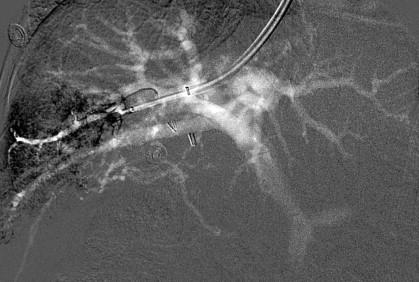Physical Address
304 North Cardinal St.
Dorchester Center, MA 02124
In 1969 Rosch and colleagues reported the first transjugular portal venography and portacaval shunt placement in a canine model. At that time, they foresaw the potential therapeutic benefits of transjugular intrahepatic portosystemic shunt (TIPS) placement and recognized the importance of selecting the appropriate stent material for optimal shunting. In 1982 Colapinto and co-workers performed the first TIPS in a 54-year-old man with cirrhosis and bleeding esophageal varices. In 1988 the first successful TIPS performed with a bare metal stent was reported by Rössle and associates at the University of Freiburg. However, in-stent stenosis and occlusion complicated a large number of early TIPS procedures. In the past decade the development of expanded polytetrafluoroethylene (ePTFE)–covered stents has led to improved patency rates and decreased clinical relapse rates.
Predicting survival after a TIPS procedure. The Child-Pugh score and model for end-stage liver disease (MELD) score predict survival after a TIPS procedure. The Child-Pugh score includes serum albumin, bilirubin, and prothrombin time, as well as degree of hepatic encephalopathy and ascites. Using these five variables, a score between 1 and 15 is determined, and patients are categorized as class A, B, or C, with C indicative of the most severe level of hepatic dysfunction. The MELD score is calculated using an empirically derived formula based on serum creatinine, bilirubin, and international normalized ratio (INR) levels.
Management of upper gastrointestinal (UGI) bleeding. UGI bleeding from variceal hemorrhage is initially managed by endoscopy and medical treatment, which successfully control bleeding in 80% to 90% of cases. In both acute and recurrent variceal hemorrhage, endoscopy is required before the TIPS procedure for diagnosis, localization of bleeding site, and possible treatment. Placement of a Sengstaken-Blakemore tube in the acute setting may temporarily tamponade UGI bleeding. Early intubation should be considered to prevent aspiration. Packed red blood cell transfusion and fluid resuscitation may be required for hemodynamic stabilization, and fresh frozen plasma or platelets may be needed to correct coagulopathy.
Management of ascites. TIPS may be considered for patients with ascites that is refractory to treatment by sodium restriction and diuretic therapy. Paracentesis may be performed prior to a TIPS procedure in those patients with large or tense ascites.
Cardiovascular evaluation. Suspicion of right heart failure or pulmonary hypertension should prompt cardiology evaluation as both are relative contraindications to TIPS placement. In all patients, arterial blood pressure monitoring is recommended during the TIPS procedure.
Management of hepatic encephalopathy. TIPS may lead to or exacerbate hepatic encephalopathy. Use of nonabsorbable disaccharides or antibiotics has not reduced this risk.
Duplex ultrasound examination. Before the TIPS procedure, portal and hepatic venous systems should be evaluated by duplex ultrasound.
Prophylactic antibiotics. Cephalosporin or, in the presence of a penicillin allergy, vancomycin is administered before the TIPS procedure.
Intraperitoneal hemorrhage and injury to perihepatic structures. Potential injury may occur to the gallbladder, kidney, bowel, pericardium, and abdominal wall. Avoiding these complications requires the intrahepatic portal vein to be accessed at least 2 cm from the left-right bifurcation while minimizing puncture of the liver capsule.
Correct selection and identification of the target hepatic vein
Visualization and access of the target portal vein
Selection of adequate shunt diameter and length
Avoiding an acutely angulated shunt
TIPS can be constructed from any large hepatic vein, but the right or middle hepatic vein is preferred. Most important, however, is recognizing which vein has been selectively catheterized. The ostium of the right hepatic vein lies more lateral to the middle hepatic vein and tends to course in a more lateral, often posterolateral direction, approximately in the coronal plane. Oblique projections during fluoroscopic imaging, as well as attention to the direction of the TIPS access needle hub, aid in this distinction with contrast injection further differentiating the right from the middle hepatic vein. In 85% of patients the middle hepatic vein and left hepatic vein originate from a shared ostium. The marginal right vein, a small tributary that courses within the superior right lobe and parallels the right hemidiaphragm, joins the right hepatic vein within a few centimeters of the inferior vena cava (IVC) and is not visualized in a middle hepatic venogram.
Balloon occlusion wedged carbon dioxide (CO 2 ) venography helps map the portal venous system and aids in targeting and cannulation ( Fig. 57-1 ). In some cases, however, hepatic vein collateral vessels may shunt away the injected CO 2 and thus prevent successful portal venography. It should be noted that iodinated contrast should not be used for wedged portal venography, because it does not easily cross the hepatic sinusoids and may lead to parenchymal staining. Wedged CO 2 venograms may be repeated in multiple projections to provide a mental map of the three-dimensional relationship between the hepatic vein and the portal vein. If wedged portal venography cannot be successfully performed, portal system access can still be established with “blind” passes toward the expected anatomic location of the right portal vein. Reviewing available cross-sectional imaging before the procedure is recommended.

Establishing access into the targeted portal vein is the crucial step in the TIPS procedure. The needle should be advanced in a single motion from the selected hepatic vein toward the portal vein, with a firm movement, only after careful consideration of the direction and approximate distance to the targeted vessel. It should be remembered that the consistency, as well as the size and morphology of the liver, is altered depending on the severity of cirrhosis.
Become a Clinical Tree membership for Full access and enjoy Unlimited articles
If you are a member. Log in here